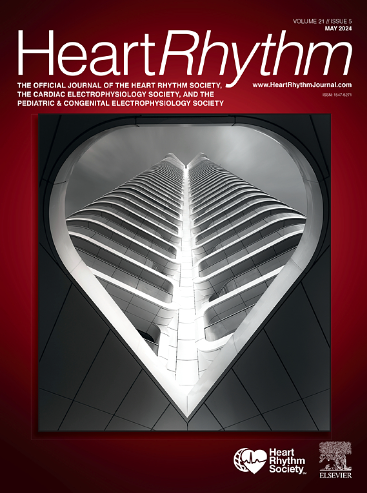Imaging findings associated with costoclavicular intervention during lead extraction
IF 5.6
2区 医学
Q1 CARDIAC & CARDIOVASCULAR SYSTEMS
引用次数: 0
Abstract
Background
Binding sites in the costoclavicular space are commonly encountered during transvenous lead extraction. Severe adhesions may warrant use of more aggressive rotational cutting tools or surgical intervention. It is not known whether preprocedural multidetector computed tomography (MDCT) can provide information about the likelihood that a patient will require costoclavicular intervention.
Objective
The purpose of this study was to determine whether there are preprocedural MDCT findings associated with need for intervention in the costoclavicular space during lead extraction.
Methods
Patients who underwent lead extraction and required use of stiffer rotational cutting tools (TightRail Sub-C) or surgical intervention in the costoclavicular space as well as age- and sex-matched controls who did not require intervention were included. Preprocedural MDCT was evaluated for patterns of lead tethering to bone and adjacent calcification.
Results
Overall, 56 patients were included (n = 20 Sub-C only, n = 8 surgical intervention, and n = 28 matched controls). The mean patient age of interventional cases was 65.0 ± 14.7 years, 18% were female, and the mean lead age was 12.3 ± 6.2 years. Four major patterns were identified on imaging: lead surrounded 360° by fat (intervention rate, 5/24 patients); lead tethered to bone by <180° (11/19); no tethering of lead but with associated calcifications (3/4); and lead tethered to bone by >180° (9/9). Tethering of at least 1 lead to bone by >180° was associated with a 100% rate of costoclavicular intervention and the highest rate of surgical intervention (56%). Absence of any degree of bone tethering was associated with a 0% rate of surgical intervention.
Conclusion
Computed tomography captures details of costoclavicular binding that appear to correlate with the need for adjunctive extraction techniques, including surgical intervention. Computed tomography may be useful in preprocedural planning for adhesions in the costoclavicular space.

取铅过程中与肋锁关节介入相关的成像结果。
背景:在经静脉引线拔出过程中,肋锁间隙中的粘连部位很常见。严重的粘连可能需要使用更先进的旋转切割工具或手术干预。目前尚不清楚手术前多载体计算机断层扫描(MDCT)能否提供患者需要进行肋锁关节介入治疗的可能性:本研究的目的是确定术前多载体计算机断层扫描(MDCT)结果是否与拔除引线过程中需要对肋锁骨间隙进行干预有关:方法:研究对象包括需要使用较硬的旋转切削工具(TightRail Sub-C)或在肋锁间隙进行手术干预而接受导联取出术的患者,以及年龄和性别匹配、不需要干预的对照组患者。对手术前的 MDCT 进行了评估,以确定引线与骨和邻近钙化的拴系模式:共纳入 56 例患者(20 例仅接受 Sub-C,8 例接受手术干预,28 例为匹配对照)。介入治疗病例的平均年龄为 65.0 ± 14.7 岁,18% 为女性,平均导联年龄为 12.3 ± 6.2 岁。在成像中发现了四种主要模式:导线被脂肪360°环绕(干预率为5/24例患者);导线与骨骼180°系留(9/9例)。至少一根导线与骨骼的拴系角度大于 180°,肋锁关节介入率为 100%,手术介入率最高(56%)。没有任何程度的骨拴系,手术干预率为0%:结论:CT 可捕捉到肋锁关节结合的细节,这些细节似乎与包括手术干预在内的辅助性拔除技术的需求相关。CT 可用于肋锁间隙粘连的术前规划。
本文章由计算机程序翻译,如有差异,请以英文原文为准。
求助全文
约1分钟内获得全文
求助全文
来源期刊

Heart rhythm
医学-心血管系统
CiteScore
10.50
自引率
5.50%
发文量
1465
审稿时长
24 days
期刊介绍:
HeartRhythm, the official Journal of the Heart Rhythm Society and the Cardiac Electrophysiology Society, is a unique journal for fundamental discovery and clinical applicability.
HeartRhythm integrates the entire cardiac electrophysiology (EP) community from basic and clinical academic researchers, private practitioners, engineers, allied professionals, industry, and trainees, all of whom are vital and interdependent members of our EP community.
The Heart Rhythm Society is the international leader in science, education, and advocacy for cardiac arrhythmia professionals and patients, and the primary information resource on heart rhythm disorders. Its mission is to improve the care of patients by promoting research, education, and optimal health care policies and standards.
 求助内容:
求助内容: 应助结果提醒方式:
应助结果提醒方式:


